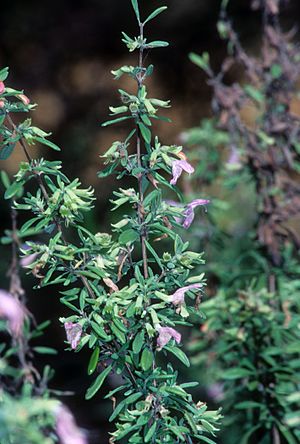Etonia rosemary facts for kids
Quick facts for kids Etonia rosemary |
|
|---|---|
 |
|
| Conservation status | |
| Scientific classification | |
| Genus: |
Conradina
|
| Species: |
etonia
|
Conradina etonia is a very rare type of shrub that belongs to the mint family. People often call it the Etonia rosemary because it smells a bit like rosemary. This special plant only grows in one place in the world: Putnam County, Florida. There are fewer than 1,000 of these plants left, found in about eight small groups, mostly within the Etoniah Creek State Forest. It needs a very specific kind of home to grow, and its biggest problem is that its natural habitat is being destroyed or changed. Because it's so rare and in danger, the United States government has listed it as an endangered species.
Contents
What Does the Etonia Rosemary Look Like?
This plant is a shrub that smells nice and has many branches. It can grow up to about 1.5 meters (about 5 feet) tall. Its leaves have tiny hairs and veins, and their edges are often rolled inwards.
When the plant blooms, it produces clusters of pretty lavender (light purple) flowers. Each flower has two "lips" and is marked with darker lines and dots. These colorful flowers are very attractive to bees and butterflies, which help the plant reproduce.
Where Does the Etonia Rosemary Live?
The Etonia rosemary is a natural part of the Florida scrub ecosystem. This is a unique type of habitat found in Florida. It grows alongside other plants like sand pines (Pinus clausa), scrub palmetto (Sabal etonia), different kinds of oaks (Quercus spp.), and wild blueberries (Vaccinium spp.).
This plant's home is also where the Florida scrub jay (Aphelocoma coeleruscens) lives. The Florida scrub jay is a bird that is also considered a federally threatened species.
Why Is the Etonia Rosemary Endangered?
Scientists first found and described this plant as a new species in 1990 and 1991. By 1993, it was added to the endangered species list. This happened because only two groups of the plant were known, and both of those areas were planned to be built on.
Like many other plants in the Florida scrub, the Etonia rosemary needs natural wildfires to stay healthy. It doesn't like growing in the shade and needs open, sunny areas to thrive. When fires are stopped (this is called fire suppression), the habitat can become too thick with tall bushes and trees. These taller plants block the sunlight, which harms the smaller Etonia rosemary plants.
Research has shown that the plant grows better when the forest is thinned out, for example, when some sand pines are harvested. Scientists are also looking into whether controlled burns (fires set on purpose by experts) could help the plant recover and be managed better.
How Is the Etonia Rosemary Being Protected?
After the plant was listed as endangered, the State of Florida bought much of the land where it was found. As more groups of the plant were discovered, the state continued to buy those lands too. Today, most of the Etonia rosemary plants live on protected land, mainly within the Etoniah Creek State Forest and Dunns Creek State Park. The state is still trying to buy any private land that has these special plants on it.
Because most of the plants are now on protected land, the United States Fish and Wildlife Service has suggested that the species might be moved from "endangered" to "threatened" status. This would mean it's still at risk, but not in as much immediate danger as before.


